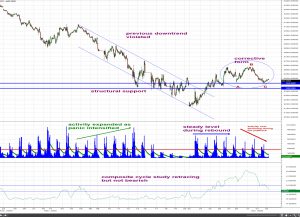
The wave principle is unique in the perspective it can give on market trends. Many technicians find themselves confused with Elliott and present as criticism the subjective nature of wave counts and how they must always be adjusted. It’s a fair point but it’s based on a practitioner flaw rather than an EWP flaw. The important thing to understand is that like any other technical tool, Elliott must not be used in isolation and must be combined with other elements of market behavior pertaining to flow, momentum, ratio, basic trend analysis, sentiment and related market confirmation. If this is done within the framework proposed by the wave personalities the results can be absolutely remarkable.
Much like the Elliott Wave Principle is an evolution of the Dow Theory, the wave personalities are a more detailed description of major trend phases. The difference really is a subtle one, in the sense that the Dow Theory’s major trend phases are distinguished in up versus downtrends – in other words the criteria here is trend direction; whereas the wave personalities are distinguished in motive versus corrective waves which can both unfold as either uptrends or downtrends – that is to say the criteria under the Wave Principle is wave function.
The Dow Theory’s third tenet suggests primary trends have three phases and they are slightly different from bull to bear markets. Rallies begin with disbelief, are dominated by trend follower interest in the middle and suck in the public at the end. Declines start with complacency, degenerate in concern in the middle portion and end with capitulation. The Dow Theory thus proposes opportunity arises somewhere where capitulation morphs into disbelief and it’s easy to see why that comes to be the case. Capitulation leads to an intense wave of selling that pushes assets to more attractive valuation levels. Also, capitulation is the final exhaust phase where everybody throws in the towel - so once it’s all done the selling pressure naturally dries up because there is nobody left to sell. The disbelief is the natural mental state of the market in the aftermath of a vicious wave of selling and is where the market is beginning to rebuild precisely because of the scars left by capitulation. Astute investors are enticed by great valuations – which creates buy flow - and the activity expands only on the rallies simply because of a complete disappearance of sellers. It makes total sense.
Elliott on the other hand proposes that opportunity arises during 2nd waves. Second waves are so called “retests of lows” and can be confirmed in two simple ways - they subdivide in a corrective a-b-c structure and do not carry to a new extreme (retracement is contained at 100% and in most cases 61.8-78.6% but sometimes 38.2-50% of wave 1). The fact that the 2nd wave doesn’t carry to a new low is a fundamental and very concrete change in market behavior because the sequence of lower highs and lower lows that will have defined the previous downtrend is now in the early stages of being broken. The inability to push to a new low despite the fact that psychology is often more extreme than at the actual market turning point and fundamentals look almost hopeless is the classical example of the market disregarding current negativity and discounting the more positive picture that will suddenly surface in the ensuing wave 3. As the say goes, the best news for a market is a market that doesn’t fall on bad news.
If you do a checklist of all these items and evaluate the current environment you will see that many things are lined up for a short-term reversal here. Calling for a bull market would be a different thing because rebuilding after black swan events takes time and frankly with this volatility and time compression, we just don’t have to do so to make a buck. Suffice is to say the negativity and the desperation we see in the news in the context of the currently prevailing technical picture IS NOT BEARISH. Consider this
- Fear at the march low almost matched the levels reached in 2008;
- The fear build up now took 3-4 weeks vs 9 months – this is an intense burst of sharply focused emotion;
- The spike in volume suggests capitulation occurred – at least for now;
- The recent rebound is largely technical and we can’t explain through fundamentals what the market seems to be doing but the immediate downtrend has been violated;
- Activity seems to be drying up during declines;
- The leg down from 2640 seems to have an a-b-c corrective form;
- Previous structural levels and initial percentage retracement seem to prop the market up pretty well so far;
- Everybody, including the media and the officials seem unable to see any hope despite the fact that tough containment measures have been instituted at this point. This is the exact opposite we had a month ago when everybody was complacent and nothing was being done against an accelerating breakout;
Bottom line: we may all have shivers on our backs but if you look on the chart below the technical evidence we see is a bit more balanced than that. In our portfolios we are now at our lowest cash position in months as we’ve deployed a bit near the low and a bit more in the past 48 hours. Let’s see what happens.

